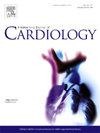Safety and efficacy of P2Y12 inhibitors in acute coronary syndromes patients with KDIGO stage IV-V renal disfunction not on dialysis: a subanalysis of the CORALYS registry
IF 3.2
2区 医学
Q2 CARDIAC & CARDIOVASCULAR SYSTEMS
引用次数: 0
Abstract
Background
The impact of the most potent P2Y12i ticagrelor and prasugrel after acute coronary syndrome in patients with chronic kidney disease (CKD) remains unclear. Most evidence on dual antiplatelet therapy (DAPT) comes from real-world study but is limited to glomerular filtration rate (GFR) under 60 ml/min.
Methods
Consecutive patients with acute coronary syndrome (ACS) treated with percutaneous coronary intervention (PCI) and severe CKD defined as GFR under 30 ml/min not on dialysis from the CORALYS registry were included. Incidence of Net Adverse Clinical Events (NACE) defined as major adverse cardiac events (cardiovascular death, myocardial infarction and unplanned revascularizations) in addition to major bleedings was our primary endpoint. Overall MACE and their single components, all bleedings, major bleedings and hospitalizations for heart failure were the secondary ones.
Results
257 patients with severe CKD not on dialysis and available data on antiplatelet regimen at discharge were included, 193 (75.1 %) were given clopidogrel while 64 (24.9 %) with ticagrelor or prasugrel. Our population was predominantly male (153, 59.5 %) with an average age 75.8 ± 10.9 years old. Over a median follow-up of 459 days, Ticagrelor and Prasugrel were associated to lower rates of NACE compared to Clopidogrel (39.9 % vs 25.0 %, p = 0.036). This was mainly driven by an excess of both CV mortality and myocardial infarction reported in the clopidogrel group. No difference was reported regarding overall bleeding events and major bleedings. At multivariate Cox regression analysis DAPT with Ticagrelor/Prasugrel resulted independently associated with a lower risk of NACE whereas left main involvement or multivessel coronary disease led to higher risk of NACE.
Conclusions
In ACS patients treated with PCI with severe CKD ticagrelor and prasugrel were associated to lower risk of NACE, MACE, CV death and myocardial infarction compared to clopidogrel. No significative difference was reported in overall and major bleedings.

P2Y12抑制剂治疗急性冠状动脉综合征伴有非透析的KDIGO IV-V期肾功能不全患者的安全性和有效性:CORALYS登记的一项亚分析
背景:慢性肾脏疾病(CKD)患者急性冠脉综合征后最有效的P2Y12i替格瑞洛和普拉格雷的影响尚不清楚。双重抗血小板治疗(DAPT)的大多数证据来自现实世界的研究,但仅限于肾小球滤过率(GFR)低于60 ml/min。方法:从CORALYS登记处纳入经皮冠状动脉介入治疗(PCI)的急性冠脉综合征(ACS)患者和GFR低于30 ml/min的非透析严重CKD患者。净不良临床事件发生率(NACE)定义为除主要出血外的主要心脏不良事件(心血管死亡、心肌梗死和计划外血运重建术)。总体MACE及其单组分、所有出血、大出血和因心力衰竭住院是次要因素。结果:257例非透析的严重CKD患者和出院时抗血小板方案的可用数据,193例(75.1% %)给予氯吡格雷,64例(24.9% %)给予替格瑞或普拉格雷。人群以男性为主(153例,59.5% %),平均年龄75.8 ± 10.9 岁。在中位459 天的随访中,与氯吡格雷相比,替格瑞洛和普拉格雷的NACE发生率较低(39.9 % vs 25.0 %,p = 0.036)。这主要是由于氯吡格雷组报告的心血管死亡率和心肌梗死的增加。总的出血事件和大出血没有差异。在多变量Cox回归分析中,DAPT联合替格瑞洛/普拉格雷与较低的NACE风险独立相关,而左主干受损伤或多支冠状动脉疾病导致较高的NACE风险。结论:与氯吡格雷相比,在接受PCI治疗的ACS重症CKD患者中,替格瑞洛和普拉格雷可降低NACE、MACE、CV死亡和心肌梗死的风险。总体出血和主要出血无显著差异。
本文章由计算机程序翻译,如有差异,请以英文原文为准。
求助全文
约1分钟内获得全文
求助全文
来源期刊

International journal of cardiology
医学-心血管系统
CiteScore
6.80
自引率
5.70%
发文量
758
审稿时长
44 days
期刊介绍:
The International Journal of Cardiology is devoted to cardiology in the broadest sense. Both basic research and clinical papers can be submitted. The journal serves the interest of both practicing clinicians and researchers.
In addition to original papers, we are launching a range of new manuscript types, including Consensus and Position Papers, Systematic Reviews, Meta-analyses, and Short communications. Case reports are no longer acceptable. Controversial techniques, issues on health policy and social medicine are discussed and serve as useful tools for encouraging debate.
 求助内容:
求助内容: 应助结果提醒方式:
应助结果提醒方式:


